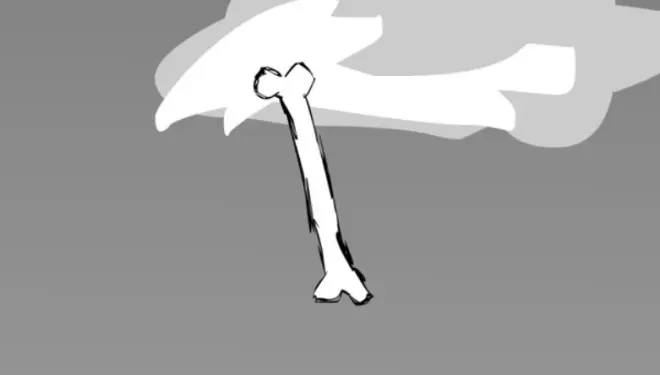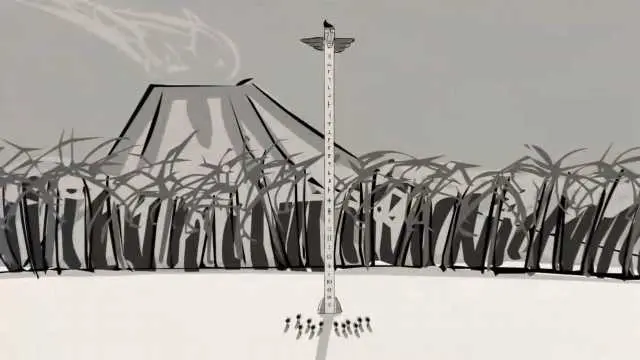【WhyU】代数入门1:数字的黎明
大家好,今天我给大家带来《代数学入门》第一集的文稿及其翻译。本集以故事的形式讲述了十进制在诞生前人们使用的计数系统。通过对比,我们直观感受到十进制的不仅可以表达任意大的数字,而且在写法上十分简便。这位我们进一步学习数字起了一个良好的开头。

大家好,我是教授冯·史莫霍,欢迎来到《数趣课堂》
Hello. I’m Professor Von Schmohawk and welcome to Why U.
这个系列的课程以介绍代数学为主。但在我们开始之前,我们首先来谈一下什么是“数字”。
This series of lectures is an introduction to Algebra. But before we discuss Algebra, we should start by taking a closer look at the things we call numbers.
在很早的文化中,数字已成为日常理解和交流数量必不可少的工具
In even the earliest cultures, understanding and communicating quantities has been essential to everyday life.
人类学家告诉我们,即便是在最原始的石器时代,数字的概念已然成形
Anthropologists tell us that even the most primitive stone-age cultures had some concept of “number”.

但是比起现在,早期的的计数系统十分简易。一切都很简单。
However, early number systems were much more limited than today's base-10 number system. Life was simple back then.
我们并不需要计量精确的数目。如果你知道附近有一群羚羊。精确测定数目和距离并非明智之举。
We didn't need names for exact quantities.If you knew that there was a herd of gazelles nearby, it didn't matter exactly how many gazelles were in the herd or exactly how many miles away they were.
重要的是那群羚羊是否能一网打进
What was important was that there were a lot of gazelles and they were just over the hill.
即便最近,一些澳洲原住民只能数到“二”,再大的数只好称“许多”
Even recently, certain Australian aboriginal tribes counted only to two, with any number larger than two called "much" or "many".
生活在亚马逊的美洲印第安人可以数到“六”,尽管他们称“三”为“二一”,称“四”为“二二”,以此类推
South American Indians along the Amazon had names for numbers up to six, although three was called "two-one", four was "two-two" and so on.
生活在南非的布须曼人也有类似的命名方法,但因为过于冗长而止步于“十”
Bushmen of South Africa had a similar way of naming quantities, but stopped at ten because the names became too long.
双方在交易物品的时候,不允许一方的数目大于“二”。
This tribe would not do "financial" transactions involving numbers greater than two.
比如说,他们不会直接用两头牛换四只猪。而是拆分成两次交易,每次用一头牛交易两只猪
For example, they would not trade two cows for four pigs. Instead, they would trade one cow for two pigs and then in a second transaction trade another cow for another two pigs.
如果你没有学过数字,但是想向别人描述你看到了多少只羚羊,你的第一选择是用手指表述羚羊的数目
If you had never heard of numbers and you wanted to describe to someone exactly how many gazelles you had seen just over the hill, you might use your fingers to represent how many gazelles there were.
当然这种方法对超过十只羚羊的情况便不那么奏效了。
Of course this would become difficult if there were more than ten gazelles.
或许你可以在木头上刻一道刻痕、用一颗石子代表一只羚羊。但是这种方法在面对众多羚羊时只会越来越繁琐。
You could cut marks on a stick or maybe gather a group of pebbles to represent the number of gazelles, but then, this would also become cumbersome if there were a lot of gazelles.
另一种方法是用不同的名字或符号来指代每一个数字。这种方法看上去简单直接,但是仍有问题。
Another option would be to invent different names and symbols for each possible quantity. This seems like a simple solution but there is still a problem.
要知道此时的你对今天通行的十进制一无所知,你需要发明一套全新的符号体系来给每个数字一一命名。
Remember that you know nothing about our modern base-10 number system which uses only ten symbols in different combinations, so you will have to invent a new word and symbol for every possible quantity.

比方说,我曾到访过一个叫“可可洛克岛”的地方。当地人是这样称呼前三十个数字的:
For instance, in my primitive tribe on Cocoloco island Here are the first thirty numbers we use.
zoop(1), floop(2), dop(3), trom(4), mim(5), zap(6), weeny(7), glumby(8), bimpy(9), neechy(10), frump(11), wackit(12), trimble(13), walaki(14), kravitz(15), jolo(16), ponzo(17), kolob(18), krub(19), wallop(20), zoomy(21), mombozo(22),balleemi(23), toramoo(24), fallazit(25), smip(26), bazooloo(27), eekeena(28), eechiwa(29), and ZORTAN(30).
过了“三十”,我们就只能说“许多”
After Zortan(30) we just say "a whole bunch".
这种计数方法有诸多问题。
There were several problems with this number system.
首先,光是记忆这三十个符号就让人难受。
First of all, since we had over thirty symbols to memorize, math was really difficult.
比如说,如果你有“十四”个椰子,然后你吃掉了“九”个椰子,还剩下多少个椰子?
For instance, if you have “walaki(14)” coconuts, and then you eat “mim(5)” coconuts, how many are left?
答案显然是“九”个椰子。
The answer is obviously “bimpy(9)” coconuts
但是要记住所有的组合需要经过漫长的学习。
but it takes many years of school to memorize all the combinations.
此外,如果你有“二十七”个椰子,然后别人给了你“四”个,一共有多少椰子呢?
Also, what happens if you have “bazooloo(27)” coconuts and then someone gives you “trom(4)” more?
这个嘛,你便只能说“许多”椰子。
Well, then you’d have “a whole bunch of” coconuts.
其实在以前,有的本土数学家通过发明一系列新的称谓符号来拓展现有的计数体系。
In the past, some of the mathematicians on Cocoloco Island actually invented an "advanced" number system with several thousand names and symbols to handle problems like this.
但是这些体系都不能解决往最大的数字加“一”的难题。
But as soon as they did, someone always came up with a problem which they did not have a number for by adding “zoop” to the biggest number.
有一天,一位聪明的本土数学家用“组合符号”的主意解决这个问题。
Then one especially brilliant Cocoloconian mathematician came up with the idea of combining symbols.
在“三十”之后,下一个数是“三十·一”,以此类推。
After zortan(30), the next number would be zortan-zoop, then zortan-floop(30-1), and so on.
当你数到“三十·三十”,我们再用三个符号来接下去,比如“三十·三十·一”,“三十·三十·二”。
When you got to zortan-zortan(30-30), you then would go to zortan-zortan-zoop(30-30-1) and zortan-zortan-floop(30-03-2).
这种方法虽然可行,但越到后面越加冗长。
This worked well, but numbers could get quite long.
比如说,如果我们要用这种方法表示一千个椰子,就得说三十三遍“三十”还要加上“十”。
For instance, our number "one-thousand" in Cocoloconian would be zortan*30-neechy
如果要写出来更加麻烦。
which we would write as ...
许多年后,人们意识到一起一遍又一遍的写“三十”。
After many years, people realized that it wasn’t necessary to write zortan over and over.
我们可以直接用“三十”出现的次数代替。
The first symbol could just represent the number of zortans.
举个例子,“三十·三十·三十·一”可以简写成“三·一”。
For instance, the number zortan-zortan-zortan-zoop would be dop-zoop, three zortans plus a zoop.
“三十·三十·三十·三十·一”可以简写成“四·一”。
Zortan-zortan-zortan-zortzan-zoop would be trom-zoop, four zortans plus a zoop.
第一个位置最多可以表示三十个“三十”的个数,即我们的九百。
The first symbol could represent up to zortan zortans, or 900.
因此这种两位制计数方法只能数到我们的一千,尽管当时这是个大数目
This two-symbol system still couldn't quite get up to 1000 , but nobody had that many coconuts anyway.
有一天,从遥远的棒果多果到驶来了一艘船
Then one day a boat arrived from the distant island of Bongopongo.
大伙惊呆了,因为他们发明了一种更简洁的计数方法来表示很大的数字
We were all amazed. The Bongoponganians had invented a much better system which could represent really big numbers with much fewer symbols.
显然,早期的棒果多果人用指头计数,因为一共只有十个符号。
Apparently, in early pre-history of Bongopongo they must have counted on their fingers because they only used ten different symbols. which they called “fingers” or “digits”.
他们先是用一位数从“一(1)”数到“九(9)”,接着用两位数继续下去
They counted up to bimpy, which they called “nine”, using a single digit. After “nine”, they used two digits.
第一位表示“十(10)”的次数,第二位则是在此基础上累加
The first digit represented some number of tens, and the second digit would add from nothing to nine to that.
比如,数字“32”代表三个“十(10)”以及两个“一(1)”
For instance, the number 32 would represent three tens and two ones.
数字“47”代表四个“十(10)”以及七个“一(1)”
The number 47 would be four tens and seven ones.
类似的,数字“80”代表八个“十(10)”以及零个“一(1)”
Likewise, the number 80 would be eight tens and zero ones.
但是这种计数法的厉害之处在于,当数到“99”时,所有人都觉得到头了。
But here is where their number system was really amazing. After getting up to 99, you would think that they would have to stop.
但是,奇迹发生了!他们只需要在前面加上一个数字,来表示“百(100)”的个数,这样便能一直数到“九百·九十·九(999)”了
But no! They would just tack on another symbol in front which would now be used to represent hundreds.This could take you all the way to 999, which meant nine hundreds plus nine tens plus nine ones.
每一次到所谓最大的数,他们只需要在前面加上一位,便能继续数下去
Every time they got to the biggest number they could represent, they would just tack on another digit which represented the next bigger number and kept going!
这个计数方法有几大优势,首先我们只需要记住十个数字
This system had some big advantages. First of all there were only ten different symbols to remember.
其次,这种计数法每加一位,计数范围便能扩大原来的十倍。所以只需六位数便能统计最多一百万个椰子,那真够多的!
Secondly, every time they added a digit, they could represent a number ten times bigger. So with six digits they could represent almost a million. That’s a lot of coconuts!
回顾之前的计数方法,我们容易看出第一套方法的问题所在:
Looking back, it is easy to see the problem with the first Cocoloconian number system.
如果给每一个数取一个名字,名字肯定不够用。
Each quantity required a new symbol, so when you ran out of symbols, you ran out of numbers.
如果有三十个符号,我们最大只能数到三十。
With thirty symbols, the largest quantity that could be represented was thirty.
第二种方法采用了组合符号的方法,用多个符号表示一个数字。
The second system allowed these symbols to be combined in a single number and their values added.
但是因为没有进位的机制,所以数字越大表示越冗长。
But since each symbol could add no more than thirty to a number, numbers got big really quick.
第三种方法用两个符号简化了第二种方法的写法,使得计数更加简便。
The third Cocoloconian system could combine two symbols one of which was multiplied by a factor of thirty. This allowed larger quantities to be created with only two digits.
然而,这种方法只能表示1000以内的数。
However, the largest number was still less than 1000.
与此形成鲜明对比的是,棒果多果的方法只使用了十个符号
On the other hand, the Bongoponganian system used only ten symbols.
但是只需这十个符号,配上便捷的进位制,便能以很少的数字表示很大的数目。
However, with just these ten symbols, very large quantities could be represented with just a few digits since each additional digit in a number represented a quantity ten times bigger than the previous digit.
这种计数方法简单有效,并且表示的数字没有上限
This system was simple and efficient and the quantities that could be represented were unlimited.
这便是现在通行全球的“十进位”计数方法
That is why this is the number system that the world uses today.

